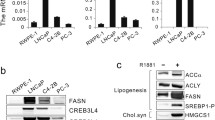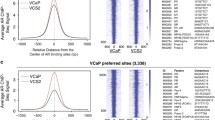Abstract
Stearoyl-CoA desaturase (SCD), the rate-limiting enzyme in the biosynthesis of monounsaturated fatty acids, is highly expressed in prostate cancer although the SCD protein has been known to be rapidly turned over by proteolytic cleavage. The present data demonstrate that SCD can promote proliferation of androgen receptor (AR)-positive LNCaP prostate cancer cells and enhance dihydrotestosterone (DHT)-induced AR transcriptional activity, resulting in increased expression of prostate-specific antigen (PSA) and kallikrein-related peptidase 2 (KLK2). Interestingly, among the previously reported SCD-derived peptides produced by proteolytic cleavage of SCD, a peptide spanning amino acids 130–162 of SCD (SCD-CoRNR) contained the CoRNR box motif (LFLII) and enhanced AR transcriptional activity. In contrast, a mutant SCD-CoRNR in which Leu136 was replaced by Ala had no effect on AR transcriptional activity. Moreover, SCD-CoRNR directly interacted with AR and inhibited RIP140 suppression of AR transactivation. Knockdown of the SCD gene by SCD microRNA suppressed AR transactivation with decreased cell proliferation, suggesting that SCD may regulate the proliferation of LNCaP cells via modulation of AR transcriptional activity. Moreover, ectopic expression of SCD in LNCaP cells facilitated LNCaP tumor formation and growth in nude mice. Together, the data indicate that SCD plays a key role in the regulation of AR transcriptional activity in prostate cancer cells.
Similar content being viewed by others
References
Askari, B., Carroll, M.A., Capparelli, M., Kramer, F., Gerrity, R.G., and Bornfeldt, K.E. (2002). Oleate and linoleate enhance the growth-promoting effects of insulin-like growth factor-I through a phospholipase D-dependent pathway in arterial smooth muscle cells. J. Biol. Chem. 277, 36338–36344.
Brinkmann, A.O., and Trapman, J. (2000). Prostate cancer schemes for androgen escape. Nat. Med. 6, 628–629.
Carascossa, S., Gobinet, J., Georget, V., Lucas, A., Badia, E., Castet, A., White, R., Nicolas, J.C., Cavailles, V., and Jalaguier, S. (2006). Receptor-interacting protein 140 is a repressor of the androgen receptor activity. Mol. Endocrinol. 20, 1506–1518.
Chang, C., Norris, J.D., Gron, H., Paige, L.A., Hamilton, P.T., Kenan, D.J., Fowlkes, D., and McDonnell, D.P. (1999). Dissection of the LXXLL nuclear receptor-coactivator interaction motif using combinatorial peptide libraries: discovery of peptide antagonists of estrogen receptors alpha and beta. Mol. Cell. Biol. 19, 8226–8239.
Chawla, A., Repa, J.J., Evans, R.M., and Mangelsdorf, D.J. (2001). Nuclear receptors and lipid physiology: Opening the X-files. Science 294, 1866–1870.
Chen, Y., Kerimo, A., Khan, S., and Wei, L.N. (2002). Real-time analysis of molecular interaction of retinoid receptors and receptor-interacting protein 140 (RIP140). Mol. Endocrinol. 16, 2528–2537.
Culig, Z., Comuzzi, B., Steiner, H., Bartsch, G., and Hobisch, A. (2004). Expression and function of androgen receptor coactivators in prostate cancer. J. Steroid. Biochem. Mol. Biol. 92, 265–271.
Enoch, H.G., Catala, A., and Strittmatter, P. (1976). Mechanism of rat liver microsomal stearyl-CoA desaturase. Studies of the substrate specificity, enzyme-substrate interactions, and the function of lipid. J. Biol. Chem. 251, 5095–5103.
Fritz, V., Benfodda, Z., Rodier, G., Henriquet, C., Iborra, F., Avances, C., Allory, Y., de la Taille, A., Culine, S., Blancou, H., et al. (2010). Abrogation of de novo lipogenesis by stearoyl-CoA desaturase 1 inhibition interferes with oncogenic signaling and blocks prostate cancer progression in mice. Mol. Cancer Ther. 9, 1740–1754.
Gerbod-Giannone, M.C., Del Castillo-Olivares, A., Janciauskiene, S., Gil, G., and Hylemon, P.B. (2002). Suppression of cholesterol 7alpha-hydroxylase transcription and bile acid synthesis by an alpha1-antitrypsin peptide via interaction with alpha1-fetoprotein transcription factor. J. Biol. Chem. 277, 42973–42980.
He, B., Minges, J.T., Lee, L.W., and Wilson, E.M. (2002). The FXXLF motif mediates androgen receptor-specific interactions with coregulators. J. Biol. Chem. 277, 10226–10235.
He, B., Gampe, R.T., Jr., Kole, A.J., Hnat, A.T., Stanley, T.B., An, G., Stewart, E.L., Kalman, R.I., Minges, J.T., and Wilson, E.M. (2004). Structural basis for androgen receptor interdomain and coactivator interactions suggests a transition in nuclear receptor activation function dominance. Mol. Cell 16, 425–438.
Heinemann, F.S., Korza, G., and Ozols, J. (2003). A plasminogen-like protein selectively degrades stearoyl-CoA desaturase in liver microsomes. J. Biol. Chem. 278, 42966–42975.
Heldring, N., Pike, A., Andersson, S., Matthews, J., Cheng, G., Hartman, J., Tujague, M., Strom, A., Treuter, E., Warner, M., et al. (2007). Estrogen receptors: how do they signal and what are their targets. Physiol. Rev. 87, 905–931.
Hodgson, M.C., Shen, H.C., Hollenberg, A.N., and Balk, S.P. (2008). Structural basis for nuclear receptor corepressor recruit-ment by antagonist-liganded androgen receptor. Mol. Cancer Ther. 7, 3187–3194.
Hu, X., and Lazar, M.A. (1999). The CoRNR motif controls the recruitment of corepressors by nuclear hormone receptors. Nature 402, 93–96.
Hu, Y.C., Yeh, S., Yeh, S.D., Sampson, E.R., Huang, J., Li, P., Hsu, C.L., Ting, H.J., Lin, H.K., Wang, L., et al. (2004). Functional domain and motif analyses of androgen receptor coregulator ARA70 and its differential expression in prostate cancer. J. Biol. Chem. 279, 33438–33446.
Jemal, A., Siegel, R., Ward, E., Murray, T., Xu, J.Q., and Thun, M.J. (2007). Cancer statistics, 2007. CA Cancer J. Clin. 57, 43–66.
Kim, E., Ma, W.L., Lin, D.L., Inui, S., Chen, Y.L., and Chang, C. (2007). TR4 orphan nuclear receptor functions as an apoptosis modulator via regulation of Bcl-2 gene expression. Biochem. Biophys. Res. Commun. 361, 323–328.
Leitzmann, M.F. (2005). Is there a link between macronutrient intake and prostate cancer? Nat. Clin. Pract. Oncol. 2, 184–185.
Lu, G., Morinelli, T.A., Meier, K.E., Rosenzweig, S.A., and Egan, B.M. (1996). Oleic acid-induced mitogenic signaling in vascular smooth muscle cells. A role for protein kinase C. Circ. Res. 79, 611–618.
Man, W.C., Miyazaki, M., Chu, K., and Ntambi, J.M. (2006). Membrane topology of mouse stearoyl-CoA desaturase 1. J. Biol. Chem. 281, 1251–1260.
Menendez, J.A., and Lupu, R. (2007). Fatty acid synthase and the lipogenic phenotype in cancer pathogenesis. Nat. Rev. Cancer 7, 763–777.
Mziaut, H., Korza, G., and Ozols, J. (2000). The N terminus of microsomal delta 9 stearoyl-CoA desaturase contains the sequence determinant for its rapid degradation. Proc. Natl. Acad. Sci. USA 97, 8883–8888.
Niu, Y.J., Yeh, S.Y., Miyamoto, H., Li, G.H., Altuwaijri, S., Yuan, J.Q., Han, R.F., Ma, T.X., Kuo, H.C., and Chang, C.S. (2008). Tissue prostate-specific antigen facilitates refractory prostate tumor progression via enhancing ARA70-regulated androgen receptor transactivation. Cancer Res. 68, 7110–7119.
Paine, E., Palmantier, R., Akiyama, S.K., Olden, K., and Roberts, J.D. (2000). Arachidonic acid activates mitogen-activated protein (MAP) kinase-activated protein kinase 2 and mediates adhesion of a human breast carcinoma cell line to collagen type IV through a p38 MAP kinase-dependent pathway. J. Biol. Chem. 275, 11284–11290.
Park, S.S., Choi, H., Kim, S.J., Kim, O.J., Chae, K.S., and Kim, E. (2008). FXR alpha down-regulates LXR alpha signaling at the CETP promoter via a common element. Mol. Cells 26, 409–414.
Scaglia, N., and Igal, R.A. (2005). Stearoyl-CoA desaturase is involved in the control of proliferation, anchorage-independent growth, and survival in human transformed cells. J. Biol. Chem. 280, 25339–25349.
Suzuki, H., Ueda, T., Ichikawa, T., and Ito, H. (2003). Androgen receptor involvement in the progression of prostate cancer. Endocr. Relat. Cancer 10, 209–216.
Thin, T.H., Wang, L., Kim, E., Collins, L.L., Basavappa, R., and Chang, C. (2003). Isolation and characterization of androgen receptor mutant, AR(M749L), with hypersensitivity to 17-beta estradiol treatment. J. Biol. Chem. 278, 7699–7708.
Torosian, M.H., and Donoway, R.B. (1991). Growth hormone inhibits tumor metastasis. Cancer 67, 2280–2283.
Werz, O., Szellas, D., Steinhilber, D., and Radmark, O. (2002). Arachidonic acid promotes phosphorylation of 5-lipoxygenase at Ser-271 by MAPK-activated protein kinase 2 (MK2). J. Biol. Chem. 277, 14793–14800.
Yeh, S., Lin, H.K., Kang, H.Y., Thin, T.H., Lin, M.F., and Chang, C. (1999). From HER2/Neu signal cascade to androgen receptor and its coactivators: a novel pathway by induction of androgen target genes through MAP kinase in prostate cancer cells. Proc. Natl. Acad. Sci. USA 96, 5458–5463.
Author information
Authors and Affiliations
Corresponding author
About this article
Cite this article
Kim, SJ., Choi, H., Park, SS. et al. Stearoyl CoA desaturase (SCD) facilitates proliferation of prostate cancer cells through enhancement of androgen receptor transactivation. Mol Cells 31, 371–377 (2011). https://doi.org/10.1007/s10059-011-0043-5
Received:
Revised:
Accepted:
Published:
Issue Date:
DOI: https://doi.org/10.1007/s10059-011-0043-5




